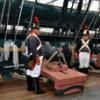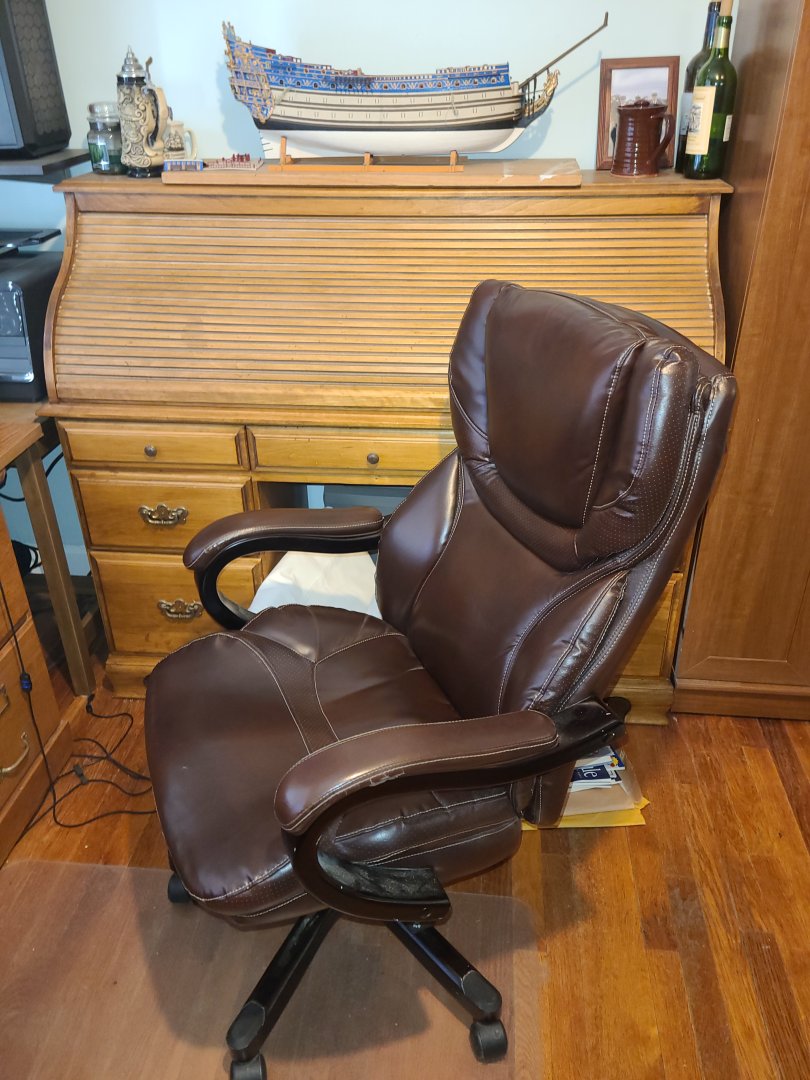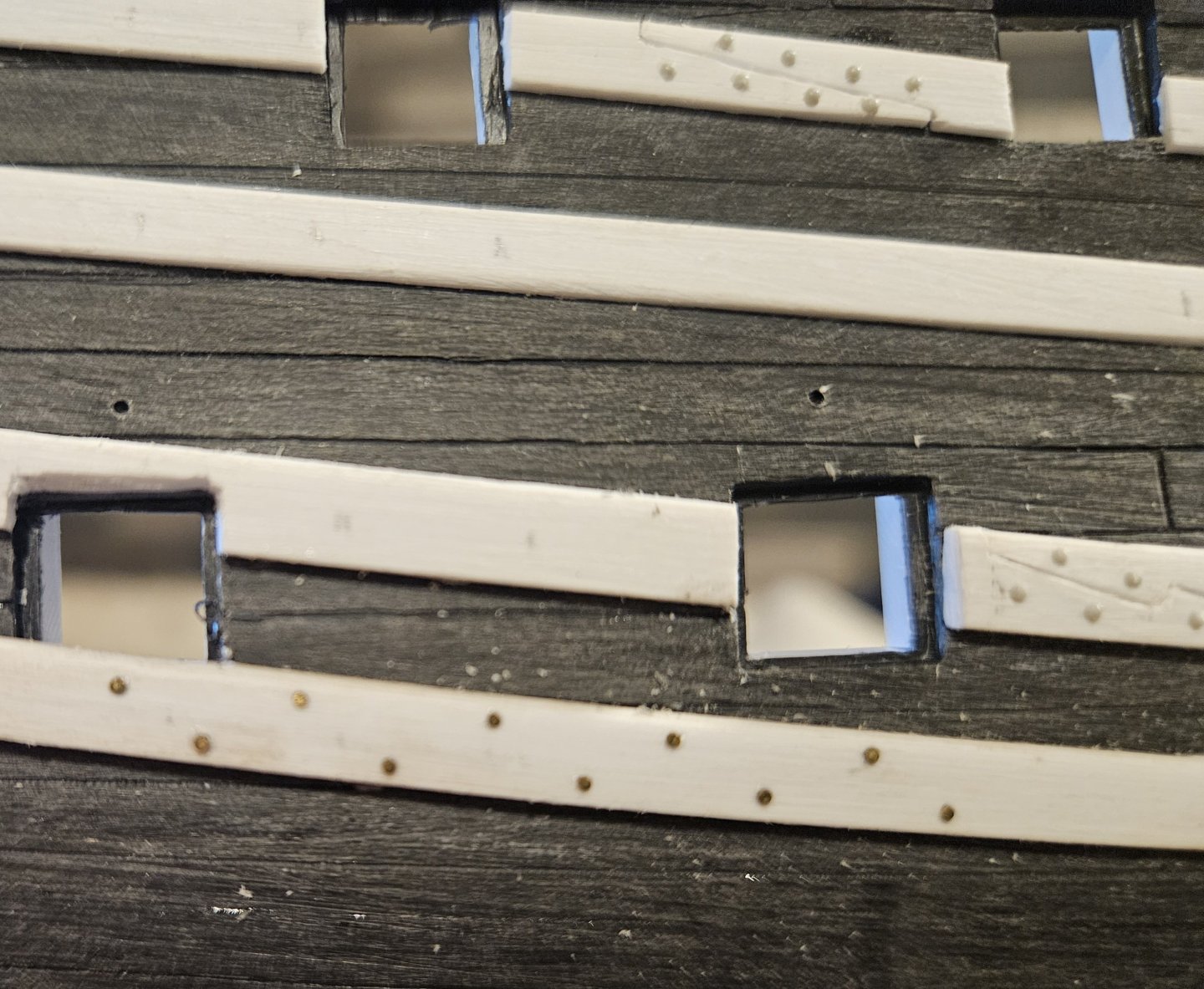-
Posts
1,933 -
Joined
-
Last visited
Content Type
Profiles
Forums
Gallery
Events
Posts posted by popeye2sea
-
-
Hello Pak75,
I can not speak to question one, but for the second, the tackles were left hooked on to the gun carriage. They acted as sort of a recoil brake as the cannon was fired. When the gun was run out to the in-battery position for firing, the tackle falls were flaked down on the deck, not coiled, so that they would run clear when the gun fired.
Regards,
Henry
BTW, Do you have a name for us to use? We are a friendly bunch here.
-
-
-
-
In order to set up a yard and stay hoisting rig (which is what that lifting rig is called) you need two separate hauling parts.
One tackle is rigged over the main hatch with the tackle attached to the main stay. The other tackle is a yard tackle suspended from the lower yard arm.
The lower blocks for both tackles come together and are hooked into the sling holding the load.
In order to launch a boat.
Step 1. Hoist away on the stay tackle, which is directly over the load, so that the load is high enough to clear the side bulwarks. The yard tackle holds fast or takes up slack. The stay tackle bears the load.
Step 2. Haul the load outboard by heaving on the yard tackle. The stay tackle is eased as needed. Both tackles bear the load.
Step 3. Once the load is directly beneath the yard tackle outboard of the ship, lower away on the yard tackle. Ease the stay tackle as needed. The stay tackle bears the load until the boat is in the water.
The process is reversed for getting cargo into the ship.
Regards,
Henry
P.S. The actual rig is slightly more complicated because you need relieving lifts and rolling tackles on the yard to help it bear the weight of the load.
P.P.S I took a ship loading operations course for the US Navy Military Sealift Command. I found the yard and stay rig to be the most fun to rig and operate. The gantry crane with a container spreader being a close second.
Regards,
Henry
-
The 10/0 beads should be good to use. I used them for my main and fore yards, They may even be a bit too large. I think they may end up being too large for the upper yards. I will be looking for some 13/0 or so for those later.
I would not use anything larger than 10/0.
Regards,
Henry
-
I believe rope was sold by the fathom. Cables were made in lengths of 100 fathoms and different rope sizes were made to a certain weight standard. For instance 100 fathoms of 14 inch cable was to weigh 41 cwt. Cablets were made in 120 fathom lengths, and Hawsers were made in 130 fathom lengths. 130 fathoms of 4 inch hawser weighed 5 cwt.
Information is from Steels elements of rope making.
Regards,
Henry
-
The standing part of the runner could either have an eye spliced in the end and the eye seized to ringbolt B, or there could be an eye spliced with a hook and hooked to the ringbolt. I am fairly certain that the runner would not be spliced directly through the ringbolt.
The same can be said about the lower tackle block at ringbolt A. Except that is more likely to have a hook spliced into a becket on the block.
Most rigging is set up so that removing the line does not entail cutting the rope itself so to facilitate using the tackle in a new location without the hassle of re-splicing the line or having to re-rig an entire line because it is now too short. It is far more efficient to just cut a seizing to remove or shift the tackle.
Regards,
Henry
- John Ruy, thibaultron, mtaylor and 1 other
-
 4
4
-
Perhaps you could ask the moderators to move your build log to the correct sub-forum: Kit build logs for subjects built from 1501 - 1750.
Regards,
Henry
-
On Constitution, the messenger runs from the capstan forward to a viol block mounted horizontally at the inside of the stem between the hawse holes on the gun deck. There are vertical rollers placed outboard of the various stanchions that the messenger may foul on in passing. The messenger is nipped to the anchor cable. As the cable comes aboard the water drips into and is captured in the manger. The cable passes below by means of a cutout in the fore corner of the main hatch grating where it is coiled two decks below on the cable tier in the orlop/hold.
To answer your specific question, the main capstan, viol, hawse holes, messenger, and anchor cables are all on the gun deck. The cable tier is two decks below, accessible from the main hatch
Regards,
Henry
-
It is, indeed sir, a pleasure to make your acquaintance. You are most welcome here. Best of luck in finding someone to take on your estimable commission.
I remain, sir, your most obedient and humble servant.
Henry
- JohnSGG, Ryland Craze, mtaylor and 2 others
-
 5
5
-
A lot of modelers go the extra effort to approximate the correct size and style of blocks. Although there are far too many, in reality, to ever model correctly. Many modelers I see on MSW toss out the kit blocks in favor of making or purchasing more convincingly real versions.
Regards,
Henry
-
-
-
-
-
- aaronc, thibaultron, Charter33 and 2 others
-
 5
5
-
-
I believe most vessels had mast tackles on the lower masts as well as the top masts. The mast tackle pendants on the lower masts had the additional function of being able to be rigged over the hatches to facilitate lowering cargo into the ship.
Regards,
Henry
- davyboy, mtaylor and GrandpaPhil
-
 3
3
-
8 hours ago, Snug Harbor Johnny said:
Its interesting that many mistakenly think Oliver Wendell Holmes Jr. wrote 'Old Ironsides'. Holmes Jr. was a Civil War officer who shouted something like, "Get down, you fool" to President Abraham Lincoln at Fort Stevens (outside Washington D.C.) in 1864, when Confederates under Gen. Jubal Early were skirmishing at perhaps the weak point in the city's defense ring - having failed to break in the previous day before Grant's reinforcements arrived.
Lincoln was the only sitting president to come under direct enemy fire during wartime. Holmes went on to a notable Supreme Court Career (associate judge), including a number of 'landmark' decisions with lasting effect.
It was actually Oliver Wendell Holmes, SR. that wrote the poem.
Henry
-
Mast tackles are used to set up the shrouds. The topmast burton tackles can also be used to give additional support to the lower yard when the yard tackles are being employed to lift heavy items.
Regards,
Henry
- mtaylor and GrandpaPhil
-
 1
1
-
 1
1
-
11 hours ago, Jaager said:
Two of the reasons for preserving an obsolete ship:
sentimentality - a cultural symbol - purposes that both Constitution and Victory serve quite well
true historical exhibit - as direct evidence and data for what the ship actually was in the instant of time it purports to represent.
If the Ship of Theseus - had been repaired by using the same source material (species of tree, etc.), with the identical shape, and attached using the method that is identical to the original - even if none of the actual molecules are those of the ship as launched - it would be just as valid as if it had been teleported. The information would be identical and equally valid.
Both Victory and Constitution are failures by this standard. Constitution underwent "improvement" and "modernization" probably about every 20 years while on active serve and after it was saved from the breakers, been manipulated and adjusted to the preconceptions of whatever committee was in charge when repairs of the effects of time, oxygen, microbes, electromagnetic radiation, was required. Victory has seen its share of the same. Both are chimeric rather than being a frozen instant of time.
Would that we had now, and in the past, a more elaborate and minutia obsessed version of HAAMS for every vessel of some importance.
I disagree with this argument. Ships, any ships, and especially naval vessels, undergo frequent and constant modifications throughout their useful lives. How many times have you researched a build only to find that you had to choose what variant to build? Who is to say that the ship with modifications made is any less than the original vessel. Would you say that about yourself after a surgery? Are you not the same person?
As I mentioned further above in this thread, Constitution is a living, continually changing vessel. Still an active US Navy ship. Still with the 12 to 13 percent of her original structure intact. 226 years old, she requires constant maintenance. That is what happens during the major dry dockings that happen at about twenty year intervals. During her early years "improvement and modernization" was nearly constant with captains making changes to rig and armament as they saw fit. The "committee" (US Navy History and Heritage Command) has been collecting and archiving materials since 1800. They are still using plans for Constitution from the 1790's to perform maintenance and repair on the vessel. Constitution is not, and never has been, a snapshot in time exhibit. You will find on board structures from her construction in 1795, masting and rigging modifications from the late 18th and early 19th centuries, armaments from the early 1800's, hull modifications from the early 1800's, equipment that was added in the 1920's, modern fire fighting systems, and modern materials used in maintenance. She is an amalgam of her 226 year history who's function is to promote the Navy's history and heritage.
Also, she was never at risk of being broken up. That is a myth arising from the famous poem by Oliver Wendell Holmes. The Navy at that time was debating how much money to spend, what her role would be, and what the scope of her repairs should take. From the war of 1812 on, the Navy realized what a national treasure she was.
Regards,
Henry
- Canute, mtaylor and GrandpaPhil
-
 3
3
-
5 hours ago, ccoyle said:
The term spars includes both masts and yards.
To put this another way. Yard is a subset of Spar.
The definition of a spar is a round wood or metal pole.
Some items that can be called spars:
Booms
Gaffs
Yards
Masts
Spreaders
Pig Sticks
Whiskers
Marlinspike ( the dolphin striker, not the hand-held one for rope work)
Regards,
Henry
- Keith Black, CPDDET, mtaylor and 1 other
-
 4
4
-
14 hours ago, Bill Morrison said:
The SS United States is not the USS United States. SS connotes that the ship is privately owned. USS means that the ship is a national ship that operates in the United States.
Bill
Further, SS actually stands for Steam Ship as opposed to MV for Motor Vessel, or SV for Sailing Vessel.
Some other designators:
TS Training Ship
RV Research Vessel
CS Cable Ship
MT Motor Tanker
MY Motor Yacht
GTS Gas Turbine Ship
NS Nuclear Ship
Regards,
Henry






tarp over the steering area during storms?
in Discussion for a Ship's Deck Furniture, Guns, boats and other Fittings
Posted
Honestly, I don't think they would for several reasons. For example: Just one more thing to get blown out in a storm. The helmsman needs to be able to look up at the sails to make sure they are still drawing properly and not luffing. They were not concerned at all with creature comforts.
No ship I ever served in, ever rigged a tarpaulin rain cover when underway. That is only rigged in port to give cover and shade to visiting landlubbers or dignitaries. Or when holding special events on board.
Regards,
Henry